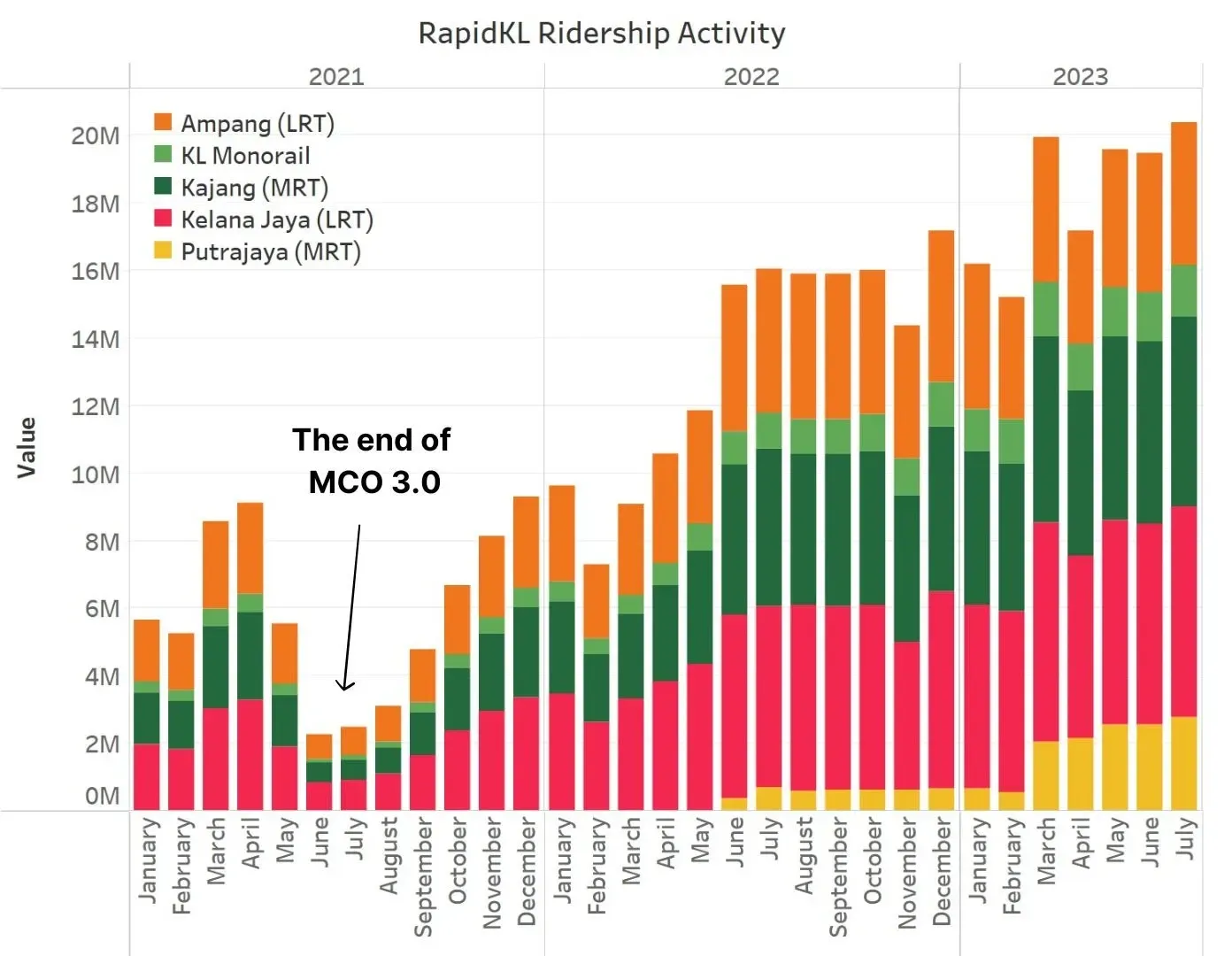Analysis of 2021-2023 train ridership and its ties to economic indicators. See how urban commuting patterns influence and reflect economic health.
The following report provides an analysis of the train ridership activity from 2021 to July 2023. We also discuss the potential implications of these trends on urban life, work patterns, and residential property.
Year-on-Year Ridership Comparison

2021 vs 2022
| Line | 2021 Ridership | 2022 Ridership | Percentage Change |
|---|---|---|---|
| Kelana Jaya | 25,123,614 | 55,015,765 | +119% |
| KL Monorail | 4,226,329 | 10,668,069 | +152% |
| Ampang | 21,938,973 | 44,151,332 | +101% |
| Kajang (MRT) | 19,573,010 | 45,348,209 | +132% |
| Putrajaya (MRT) | - | 4,147,577 | - |
2022 vs 2023 (till July)
Assuming 7 months for 2023 figures to annualize:
| Line | 2022 Ridership (7/12) | 2023 Ridership | Percentage Change |
|---|---|---|---|
| Kelana Jaya | 32,133,576 | 40,942,799 | +27% |
| KL Monorail | 6,222,707 | 9,878,030 | +59% |
| Ampang | 25,754,777 | 28,059,758 | +9% |
| Kajang (MRT) | 26,450,122 | 35,860,535 | +36% |
| Putrajaya (MRT) | 2,419,506 | 13,223,822 | +446% |
Key Observations
Post-MCO Surge: The Movement Control Order (MCO) 3.0 ended on 28th June 2021. Post that, there was a significant surge in ridership across all lines in 2022, suggesting people returned to workspaces and resumed normal commuting habits.
Introduction of the Putrajaya Line: The Putrajaya MRT line began its operations in two phases - Phase one in June 2022 and Phase two in March 2023. Its ridership saw a massive increase of 446% in 2023 (till July), indicating the rapid adoption and popularity of this new line. The introduction and expansion of new transit lines, such as the MRT Putrajaya, mean that more areas of the city become accessible to residents. This not only benefits those living in newly connected areas but also decongests existing transit lines and spreads ridership more evenly. Furthermore, network expansion can potentially open up new residential and commercial areas, leading to urban growth and development.
Increasing Trend of Kajang MRT Line: The Kajang MRT line saw a consistent increase in ridership, reflecting its importance as a key transit line.
Travel Costs: The economics of travel have a direct impact on the choices commuters make. With the increasing costs associated with driving, such as fuel prices, maintenance, and parking fees, many might find public transit a more affordable option. The introduction of schemes like the My50 travel pass further incentivizes the use of public transportation. Offering 30 days of unlimited rides across multiple modes of transportation, such initiatives make it economically attractive for daily commuters to opt for public transit over personal vehicles.
Cultural Shifts: The global narrative around sustainability and environmental consciousness is causing a shift in how people perceive and use public transportation. As concerns about carbon footprints and environmental degradation grow, many are making conscious choices to opt for more sustainable modes of transport. Trains, being a mass transit system, are viewed as a more eco-friendly alternative to individual car travel. Additionally, there is a growing preference among the younger generation for urban lifestyles that are walkable and transit-connected. This shift in cultural values is likely to further boost train ridership in the coming years.
Implications and Analysis
Back to Office Trend: The consistent year-on-year increase in ridership, especially post MCO, indicates a strong trend of people returning to office spaces. This might be attributed to organizations reverting to traditional work models or a hybrid approach, post the pandemic.
Impact on Residential Property:
- Proximity to Stations: With an increased dependence on public transportation, properties closer to train stations might see an increase in demand and potentially higher prices.
- Urbanization: The significant increase in train ridership could also suggest an increasing urban population. This could lead to a demand for more residential properties in urban areas.
- Rental Market: As people return to work, there might be a surge in demand for rental properties near business hubs and train stations.
Economic Indicators: The decline in the unemployment rate from 4.9% in January 2021 to 3.4% in June 2023, coupled with an increase in the employment-to-population ratio, indicates a recovering and robust economy. The rise in train ridership can be seen as a direct result of this positive economic trajectory, as more people have jobs to commute to.

Conclusion
The train ridership data from 2021 to 2023 paints a picture of recovery and growth post the Movement Control Order. The increased reliance on public transportation, especially trains, has multiple implications for the urban lifestyle, work culture, and the residential property market. The strategic expansion of transit networks, the rising costs of personal vehicle usage, the tangible benefits of avoiding road congestion, and evolving cultural values all contribute to the increasing reliance on trains. As cities continue to grow and evolve, these trends offer valuable insights for urban planners, policymakers, and businesses. The future of urban commuting seems to be steering towards efficient, sustainable, and interconnected transit systems. As the economy continues to grow and urbanize, it's imperative for city planners and businesses to strategize keeping these trends in mind.




